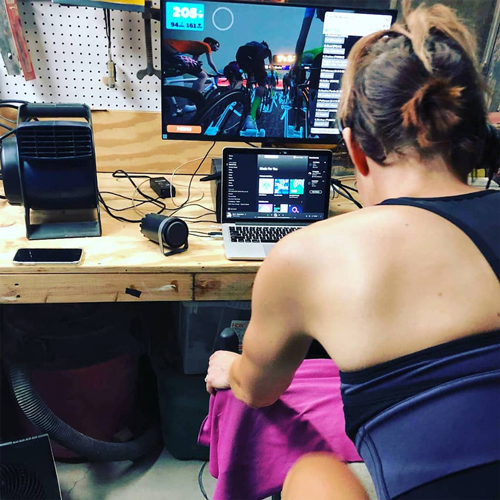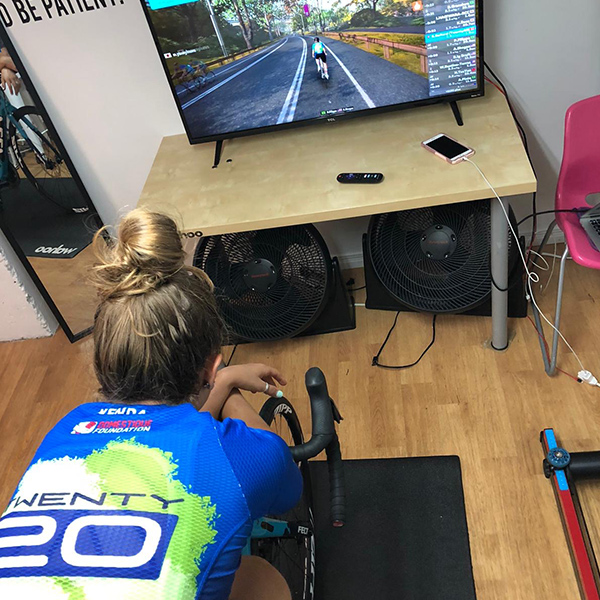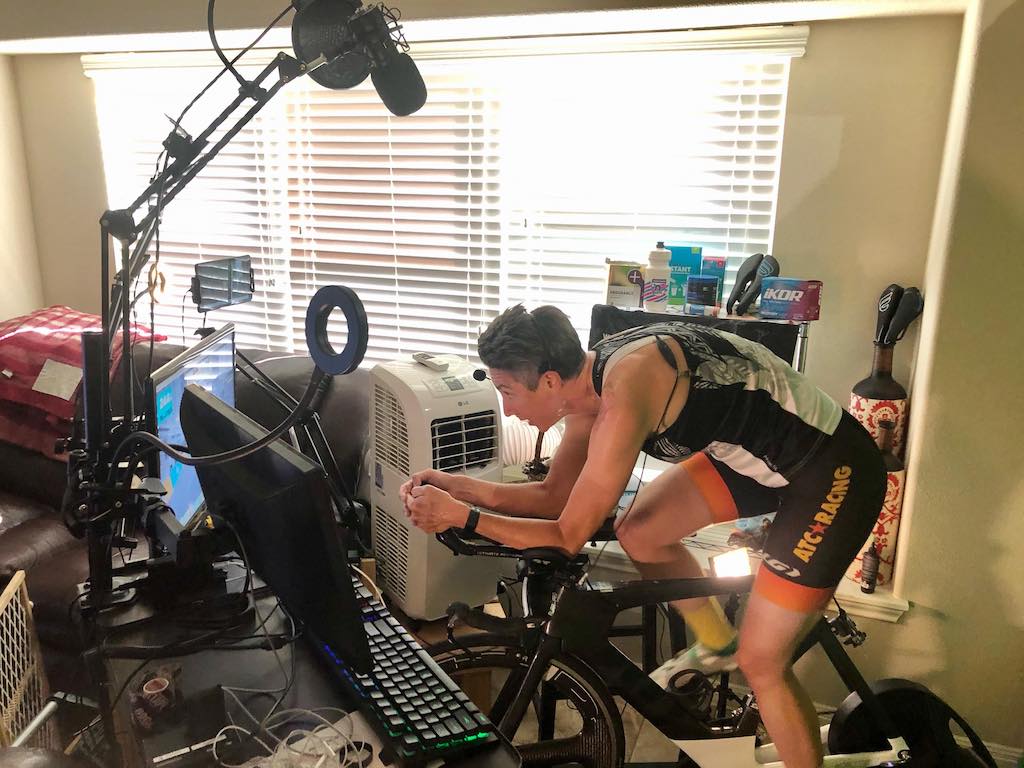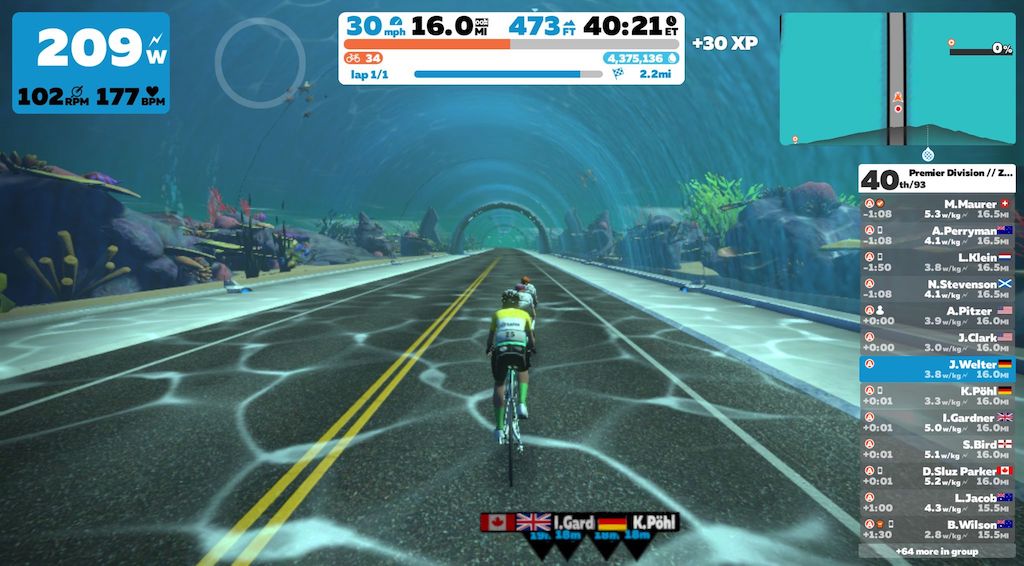I am at the start line, sweat dripping down my temples. The countdown for today’s bike race, the Zwift Pro/Am Race Series, is on. Ten more seconds, then it’s full gas. I try to calm my race nerves and remind myself of all the training I put in. The banner drops, and off I go, pedaling head-to-head with a stacked field of racers that includes German pro cyclist Tanja Erath and also Christie Tracy, current U.S. 24-hour time-trial champion and my teammate.
This excitement is happening in my basement. My Saris bike trainer is connected to a virtual race on my laptop so my legs can power my avatar. Over a headset, I plan my next moves with teammates and the directeur sportif of the esports cycling team I’ve joined, Team Saris + The Pro’s Closet. My webcam is set to an online broadcast with live commentary. Three fans blow fresh, cool air at me as my heart rate climbs quickly into the 180s.

The rise of indoor cycling
Indoor cycling has boomed during the pandemic. Even before COVID-19, though, its popularity had been growing thanks to the rise in apps designed to make riding at home more interactive and social. Spin classes such as SoulCycle and subscription-based Peloton bikes have also drawn more people to the pedals. By connecting bike trainers to apps such as BKool, Rouvy, RGT and Zwift, riders can immerse themselves in virtual experiences that simulate real-life courses. Zwift, for example, had grown to 2.5 million global users since its launch in 2015. The pandemic bumped that. New users increased by 380% from April through October, says Chris Snook, Zwift’s senior public relations manager.
These online platforms have created opportunities to connect with, train beside and race against athletes around the world, without leaving home. (Anyone with a bike and indoor trainer—or even a stationary bike—and a cycling app, can join.)
E-racing also has emerged as a new discipline in professional cycling. Several platforms hosted races with professional cyclists before the pandemic. But COVID lockdowns and restrictions on in-person launched e-racing to a new level. Riders turned to e-racing in search of competition and community. In 2020, staples of the road racing calendar became virtual events, including the Tour of the Gila in New Mexico, the Joe Martin Stage Race in Arkansas and the Tour of America’s Dairyland in Wisconsin.
Same courses, same distances
A big and unexpected benefit of people racing on a computer screen is that it quickly has helped alter the dynamic of gender inequality in bike racing—a problem that cycling has badly needed to address.
In July 2020, for example, Zwift and Amaury Sport Organisation hosted the first virtual Tour de France, a month before the postponed live event. Unlike the in-person Tour, the online version included women for the first time. Elite men and women cyclists raced identical courses and distances. They also received the same broadcast coverage. Ditto the first UCI Cycling eSports World Championships held last December on Zwift. Elite women, including my teammate Christie Tracy, raced with men over the same course. The women chased equivalent prize money as the men in events that received the same amount of broadcast streaming time.
“That’s not a situation we encounter often in the real world,” says Nicola Cranmer, team manager of Twenty24 Pro Cycling, a U.S. women’s team with a mission to create Olympic pathways for athletes. Her team placed second overall in the women’s virtual Tour de France.
Women still make up only roughly 15% of membership in USA Cycling (USAC), according to officials. Partly as a result, women racers still struggle with enormous inequality—a lack of resources, media coverage or race opportunity.

“I was shocked to see the discrepancies between the realities of male and female racers,” says Erath, who entered the pro cycling ranks in 2017 after winning the Zwift Academy. (Winners of that virtual racing competition receive a pro contract with World Tour team Canyon/SRAM). For contrast, Erath cited top-tier triathlon competition. “In triathlon, men and women have the same age groups, race the same distances, and receive the same prize money.” In cycling, “seeing different race courses, coverage and prize purses for men and women felt very foreign to me,” she says.
But esports isn’t beholden to the old way that cycling has done things. “Esports is a newer discipline, and there is nothing unequal about it,” says Twenty24’s Cranmer. “They are doing the right thing.”
Twenty24 embraced e-racing before COVID, but during the pandemic the team relied on it even more, says Cranmer. “With racing goals and even Olympic targets deferred, the schedule gave us certainty and goals to work towards,” she says. The team also recruited racers that “we would never have found without virtual racing,” she adds.

Finding a global community online
When I discovered esports in 2018, I was disillusioned with bike racing. I’d been an athlete most of my life. I had worked my way up to be a Category 2 racer in USA Cycling, which means I could race with professional teams. Even at the amateur level, racing is all-consuming and expensive, with countless hours of training and thousands of dollars invested each year. A racer spends much of the season on the road traveling from race to race. Particularly for a female cyclist, the endeavor is also frequently aggravating: Women’s races are often shorter, fields are combined across categories, and payouts are smaller than the men’s competitions. I’ve trained huge amounts for a race, driven hours to the venue, warmed up for 45 minutes—only to find that the 45-minute criterium had been shortened to less than 25 minutes.
There’s also the inherent danger of racing. I’ve crashed my bike multiple times. I’ve gone to the emergency room too often. I have faced road rage from drivers. These days I have a family and a full-time job. I love cycling, but I was no longer certain that the risks I took every week, and other sacrifices, made sense anymore.
Enter virtual racing. Through a combination of luck and hard work, I landed a spot on the esports women’s squad of Team Saris + The Pro’s Closet in 2020. Being part of a highly competitive team that built a true community with women around the globe felt amazing. Some on the team chose e-racing as a competitive outlet after having children. Teammate Anna Russell, a former professional triathlete from New Zealand, often races while her two toddlers sleep. Others started riding virtually when their work schedules limited racing on the road. Some teammates straddle both worlds. Christie Tracy already had an impressive racing career on a gravel bike when the pandemic hit. As on-road races dropped away, she shifted to e-racing. She raced as part of the U.S. National Team in the inaugural UCI eSports World Championship last December.
“E-racing is a woman’s opportunity to finally have it all,” Tracy says. “Competing at this level at age 40, all while balancing a full-time career in finance and my family, is unbelievable.”
Virtual platforms like Zwift say they are committed to continuing gender parity in the burgeoning sport. E-racing’s lower barrier to entry—requiring no travel, for instance—helps encourage this. And there has been commitment by others, too. Recently, Movistar, a Spanish pro team, announced it would create a new e-racing squad with slots for five men and five women. Today, there are women-only rides and initiatives, racing opportunities for women of all levels, as well as equal coverage and payouts. Companies are finding new marketing channels online with virtual cycling events like the SRAM Women’s Tour or Rapha’s Women’s 100.

E-racing provides more opportunities for innovative coverage, too, showing more women athletes at work. The platform gives commentators the opportunity to zoom in on racers and develop characters and their stories, says cyclist Erath. This is key, since one of the biggest hurdles for women’s sport is a lack of representation and visibility, agrees Kathryn Bertine, a former pro cyclist who started the nonprofit Homestretch Foundation. It also can help both draw in viewers while bridging the gap between elite and leisure riders. In this way, it can grow the sport.
E-racing is undeniably a form of gaming. It’s playful, it’s communal, and it’s fun. It’s also the hardest kind of bike racing I’ve ever done. And no, it’s not like racing on the road. But it’s more than pushing big watts. While you don’t fight wind and weather, there are a lot of similar strategies at play. You have to know your strengths and race according to them. You have to study the race course and your competition. And you have to understand the intricacies of the digital platforms you are using. On Zwift, you have to leverage “power ups,” which give you a special skill or benefit for a short period. On the RGT app, the game applies a “brake” when you enter a corner, and you learn quickly not to waste any watts—just like you would in a criterium race.
After over an hour of type 2-fun, I cross the virtual finish line. I gave it my all on the trainer. I didn’t end up on the podium, but I won something much more: a sense of equality and a feeling of community with the strongest women in the sport.
